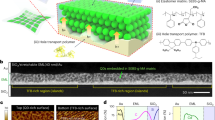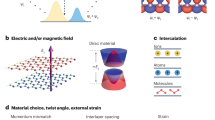Abstract
Efficient and tunable absorption is essential for a variety of applications, such as designing controlled-emissivity surfaces for thermophotovoltaic devices1, tailoring an infrared spectrum for controlled thermal dissipation2 and producing detector elements for imaging3. Metamaterials based on metallic elements are particularly efficient as absorbing media, because both the electrical and the magnetic properties of a metamaterial can be tuned by structured design4. So far, metamaterial absorbers in the infrared or visible range have been fabricated using lithographically patterned metallic structures2,5,6,7,8,9, making them inherently difficult to produce over large areas and hence reducing their applicability. Here we demonstrate a simple method to create a metamaterial absorber by randomly adsorbing chemically synthesized silver nanocubes onto a nanoscale-thick polymer spacer layer on a gold film, making no effort to control the spatial arrangement of the cubes on the film. We show that the film-coupled nanocubes provide a reflectance spectrum that can be tailored by varying the geometry (the size of the cubes and/or the thickness of the spacer). Each nanocube is the optical analogue of a grounded patch antenna, with a nearly identical local field structure that is modified by the plasmonic response of the metal’s dielectric function, and with an anomalously large absorption efficiency that can be partly attributed to an interferometric effect10. The absorptivity of large surface areas can be controlled using this method, at scales out of reach of lithographic approaches (such as electron-beam lithography) that are otherwise required to manipulate matter on the nanoscale.
This is a preview of subscription content, access via your institution
Access options
Subscribe to this journal
Receive 51 print issues and online access
$199.00 per year
only $3.90 per issue
Buy this article
- Purchase on Springer Link
- Instant access to full article PDF
Prices may be subject to local taxes which are calculated during checkout




Similar content being viewed by others
References
Bermel, P. et al. Design and global optimization of high-efficiency thermophotovoltaic systems. Opt. Express 18, A314–A334 (2010)
Hao, J. et al. High performance optical absorber based on a plasmonic metamaterial. Appl. Phys. Lett. 96, 251104 (2010)
Niesler, F., Gansel, J., Fischbach, S. & Wegener, M. Metamaterial metal-based bolometers. Appl. Phys. Lett. 100, 203508 (2012)
Landy, N. I., Sajuyigbe, S., Mock, J. J., Smith, D. R. & Padilla, W. J. Perfect metamaterial absorber. Phys. Rev. Lett. 100, 207402 (2008)
Avitzour, Y., Urzhumov, Y. A. & Shvets, G. Wide-angle infrared absorber based on a negative-index plasmonic metamaterial. Phys. Rev. B 79, 045131 (2009)
Liu, N., Mesch, M., Weiss, T., Hentschel, M. & Giessen, H. Infrared perfect absorber and its application as plasmonic sensor. Nano Lett. 10, 2342–2348 (2010)
Koechlin, C. et al. Total routing and absorption of photons in dual color plasmonic antennas. Appl. Phys. Lett. 99, 241104 (2011)
Wu, C. et al. Large-area wide-angle spectrally selective plasmonic absorber. Phys. Rev. B 84, 075102 (2011)
Tittl, A., Mai, P., Taubert, R., Dregely, D. & Giessen, N. L. H. Palladium-based plasmonic perfect absorber in the visible wavelength range and its application to hydrogen sensing. Nano Lett. 11, 4366–4369 (2011)
Wan, W. et al. Time-reversed lasing and interferometric control of absorption. Science 331, 889–892 (2011)
Shalaev, V. Optical negative-index metamaterials. Nature Photon. 1, 41–48 (2007)
Liu, X. et al. Taming the blackbody with infrared metamaterials as selective thermal emitters. Phys. Rev. Lett. 107, 045901 (2011)
Dolling, G. et al. Cut-wire pairs and plate pairs as magnetic atoms for optical metamaterials. Opt. Lett. 30, 3198–3200 (2005)
Shalaev, V. M. et al. Negative index of refraction in optical metamaterials. Opt. Lett. 30, 3356–3358 (2005)
Yu, N. et al. Light propagation with phase discontinuities: generalized laws of reflection and refraction. Science 334, 333–337 (2011)
Shadrivov, I. V., Kapitanova, P., Maslovski, S. & Kivshar, Y. Metamaterials controlled with light. Phys. Rev. Lett. 109, 083902 (2012)
Albooyeh, M. & Simovski, C. Maximal absorption and local field enhancement in planar plasmonic arrays. Preprint at http://arxiv.org/abs/1203.2100v1 (2012)
Bozhevolnyi, S. I. & Søndergaard, T. General properties of slow-plasmon resonant nanostructures: nano-antennas and resonators. Opt. Express 15, 10869–10877 (2007)
Moreau, A., Lafarge, C., Laurent, N., Edee, K. & Granet, G. Enhanced transmission of slits arrays in an extremely thin metallic film. J. Opt. A 9, 165–169 (2007)
Le Perchec, J., Quemerais, P., Barbara, A. & Lopez-Ros, T. Why metallic surfaces with grooves a few nanometers deep and wide may strongly absorb visible light. Phys. Rev. Lett. 100, 066408 (2008)
Granet, G. & Plumey, J. Parametric formulation of the Fourier modal method for crossed surface-relief gratings. J. Opt. A 4, S145 (2002)
Sun, Y. & Xia, Y. Shape-controlled synthesis of gold and silver nanoparticles. Science 298, 2176–2179 (2002)
Im, S. H., Lee, Y. T., Wiley, B. & Xia, Y. Large-scale synthesis of silver nanocubes: the role of HCl in promoting cube perfection and monodispersity. Angew. Chem. Int. Ed. 44, 2154–2195 (2005)
Decher, G. Fuzzy nanoassemblies: toward layered polymeric multicomposites. Science 277, 1232–1237 (1997)
Marinakos, S. M., Chen, S. & Chilkoti, A. Plasmonic detection of a model analyte in serum by a gold nanorod sensor. Anal. Chem. 79, 5278–5283 (2007)
Michota, A., Kudelski, A. & Bukowska, J. Molecular structure of cysteamine monolayers on silver and gold substrates: comparative studies by surface-enhanced Raman scattering. Surf. Sci. 502–503, 214–218 (2002)
Wallwork, M. L., Smith, D. A., Zhang, J., Kirkham, J. & Robinson, C. Complex chemical force titration behavior of amine-terminated self-assembled monolayers. Langmuir 17, 1126–1131 (2001)
Mock, J. J. et al. Distance-dependent plasmon resonant coupling between a gold nanoparticle and gold film. Nano Lett. 8, 2245–2252 (2008)
Hanauer, M., Pierrat, S., Zins, I., Lotz, A. & Sõnnichsen, C. Separation of nanoparticles by gel electrophoresis according to size and shape. Nano Lett. 7, 2881–2885 (2007)
Anker, J. N. et al. Biosensing with plasmonic nanosensors. Nature Mater. 7, 442–453 (2008)
Acknowledgements
This work was supported by the US Air Force Office of Scientific Research (grant no. FA9550-09-1-0562) and by the US Army Research Office through a Multidisciplinary University Research Initiative (grant no. W911NF-09-1-0539). Additional support includes US NIH grant R21EB009862, to A.C., and US NIH F32 award (F32EB009299), to R.T.H.
Author information
Authors and Affiliations
Contributions
A.M. and C.C. ran the simulations. A.M., C.C., J.J.M. and D.R.S. conducted the physical analysis. Q.W. fabricated and characterized the nanocubes. R.T.H. made the substrates (gold and polyelectrolyte layers), measured their characteristics and deposited the cubes. J.J.M. built the experimental set-up and made the measurements. All the authors provided technical and scientific insight and contributed to the writing of the manuscript.
Corresponding author
Ethics declarations
Competing interests
The authors declare no competing financial interests.
Supplementary information
Supplementary Information
This file contains Supplementary Figures 1-8 and a Supplementary Discussion. The Supplementary Figures give experimental results regarding the independency of the absorption with respect to the polarization or the incidence angle. The Supplementary Discussion gives detailed explanations for the physical mechanisms of the absorption, the critical density theoretically required for ideal absorption, the size dispersion of the cubes and how it is taken into account and the definition of the effective cross section. (PDF 283 kb)
Rights and permissions
About this article
Cite this article
Moreau, A., Ciracì, C., Mock, J. et al. Controlled-reflectance surfaces with film-coupled colloidal nanoantennas. Nature 492, 86–89 (2012). https://doi.org/10.1038/nature11615
Received:
Accepted:
Published:
Issue Date:
DOI: https://doi.org/10.1038/nature11615
This article is cited by
-
Promising thermal photonic management materials for sustainable human habitat
Nano Research (2024)
-
Polarization-insensitive and wide-angle MXene-TiN-based wideband absorber operating in the visible and near-infrared regime
Optical and Quantum Electronics (2023)
-
MXene fractal-based dual-band metamaterial absorber in the visible and near-infrared regime
Optical and Quantum Electronics (2023)
-
Plasmonic sensors based on graphene and graphene hybrid materials
Nano Convergence (2022)
-
Temperature-resilient anapole modes associated with TE polarization in semiconductor nanowires
Scientific Reports (2022)
Comments
By submitting a comment you agree to abide by our Terms and Community Guidelines. If you find something abusive or that does not comply with our terms or guidelines please flag it as inappropriate.



